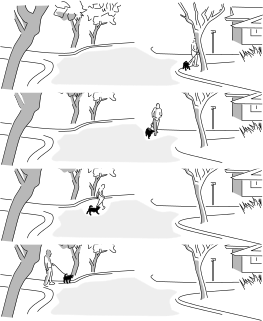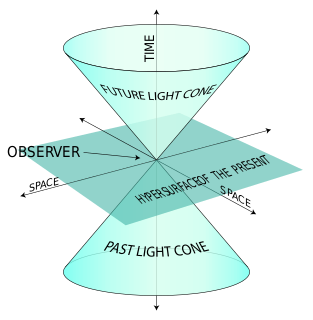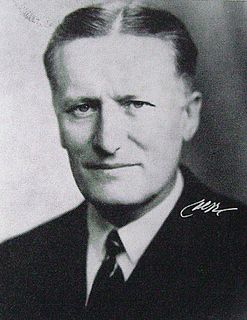
In physics, the special theory of relativity, or special relativity for short, is a scientific theory regarding the relationship between space and time. In Albert Einstein's original treatment, the theory is based on two postulates:
- The laws of physics are invariant in all inertial frames of reference.
- The speed of light in vacuum is the same for all observers, regardless of the motion of the light source or observer.

In physics, spacetime is any mathematical model which fuses the three dimensions of space and the one dimension of time into a single four-dimensional manifold. Spacetime diagrams can be used to visualize relativistic effects, such as why different observers perceive differently where and when events occur.

The theory of relativity usually encompasses two interrelated theories by Albert Einstein: special relativity and general relativity, proposed and published in 1905 and 1915, respectively. Special relativity applies to all physical phenomena in the absence of gravity. General relativity explains the law of gravitation and its relation to other forces of nature. It applies to the cosmological and astrophysical realm, including astronomy.

In physics, the twin paradox is a thought experiment in special relativity involving identical twins, one of whom makes a journey into space in a high-speed rocket and returns home to find that the twin who remained on Earth has aged more. This result appears puzzling because each twin sees the other twin as moving, and so, as a consequence of an incorrect and naive application of time dilation and the principle of relativity, each should paradoxically find the other to have aged less. However, this scenario can be resolved within the standard framework of special relativity: the travelling twin's trajectory involves two different inertial frames, one for the outbound journey and one for the inbound journey. Another way of looking at it is by realising that the travelling twin is undergoing acceleration, which makes him a non-inertial observer. In both views there is no symmetry between the spacetime paths of the twins. Therefore, the twin paradox is not a paradox in the sense of a logical contradiction.

Eternalism is a philosophical approach to the ontological nature of time, which takes the view that all existence in time is equally real, as opposed to presentism or the growing block universe theory of time, in which at least the future is not the same as any other time. Some forms of eternalism give time a similar ontology to that of space, as a dimension, with different times being as real as different places, and future events are "already there" in the same sense other places are already there, and that there is no objective flow of time.

In philosophy, philosophy of physics deals with conceptual and interpretational issues in modern physics, many of which overlap with research done by certain kinds of theoretical physicists. Philosophy of physics can be broadly lumped into three areas:

In standard cosmology, comoving distance and proper distance are two closely related distance measures used by cosmologists to define distances between objects. Proper distance roughly corresponds to where a distant object would be at a specific moment of cosmological time, which can change over time due to the expansion of the universe. Comoving distance factors out the expansion of the universe, giving a distance that does not change in time due to the expansion of space.

The world line of an object is the path that an object traces in 4-dimensional spacetime. It is an important concept in modern physics, and particularly theoretical physics.

Length contraction is the phenomenon that a moving object's length is measured to be shorter than its proper length, which is the length as measured in the object's own rest frame. It is also known as Lorentz contraction or Lorentz–FitzGerald contraction and is usually only noticeable at a substantial fraction of the speed of light. Length contraction is only in the direction in which the body is travelling. For standard objects, this effect is negligible at everyday speeds, and can be ignored for all regular purposes, only becoming significant as the object approaches the speed of light relative to the observer.
Proper length or rest length is the length of an object in the object's rest frame.

Absolute space and time is a concept in physics and philosophy about the properties of the universe. In physics, absolute space and time may be a preferred frame.

In geometry, the relation of hyperbolic orthogonality between two lines separated by the asymptotes of a hyperbola is a concept used in special relativity to define simultaneous events. Two events will be simultaneous when they are on a line hyperbolically orthogonal to a particular time line. This dependence on a certain time line is determined by velocity, and is the basis for the relativity of simultaneity.
The ladder paradox is a thought experiment in special relativity. It involves a ladder, parallel to the ground, travelling horizontally at relativistic speed and therefore undergoing a Lorentz length contraction. The ladder is imagined passing through the open front and rear doors of a garage or barn which is shorter than its rest length, so if the ladder was not moving it would not be able to fit inside. To a stationary observer, due to the contraction, the moving ladder is able to fit entirely inside the building as it passes through. On the other hand, from the point of view of an observer moving with the ladder, the ladder will not be contracted, and it is the building which will be Lorentz contracted to an even smaller length. Therefore, the ladder will not be able to fit inside the building as it passes through. This poses an apparent discrepancy between the realities of both observers.
What is now often called Lorentz ether theory (LET) has its roots in Hendrik Lorentz's "theory of electrons", which was the final point in the development of the classical aether theories at the end of the 19th and at the beginning of the 20th century.

In physics, the relativity of simultaneity is the concept that distant simultaneity – whether two spatially separated events occur at the same time – is not absolute, but depends on the observer's reference frame.

In the theory of relativity, it is convenient to express results in terms of a spacetime coordinate system relative to an implied observer. In many coordinate systems, an event is specified by one time coordinate and three spatial coordinates. The time specified by the time coordinate is referred to as coordinate time to distinguish it from proper time.
Albert Einstein presented the theories of special relativity and general relativity in publications that either contained no formal references to previous literature, or referred only to a small number of his predecessors for fundamental results on which he based his theories, most notably to the work of Henri Poincaré and Hendrik Lorentz for special relativity, and to the work of David Hilbert, Carl F. Gauss, Bernhard Riemann, and Ernst Mach for general relativity. Subsequently, claims have been put forward about both theories, asserting that they were formulated, either wholly or in part, by others before Einstein. At issue is the extent to which Einstein and various other individuals should be credited for the formulation of these theories, based on priority considerations.
Bondi k-calculus is a method of teaching special relativity popularised by Professor Sir Hermann Bondi, that has been used in university-level physics classes, and in some relativity textbooks.
In philosophy, the Rietdijk–Putnam argument, named after C. W. Rietdijk and Hilary Putnam, uses 20th-century findings in physics – specifically in special relativity – to support the philosophical position known as four-dimensionalism.

Harald Nordenson (1886–1980) was a Swedish chemist best known for his criticisms of the theory of relativity.










